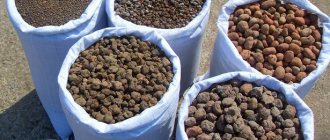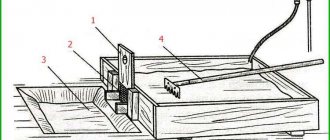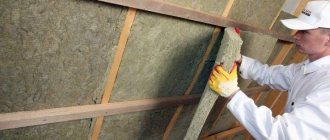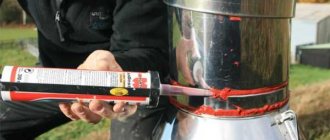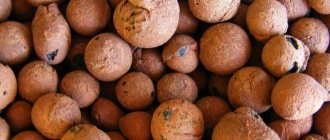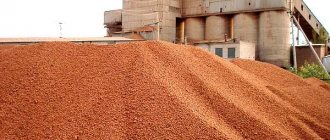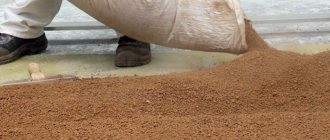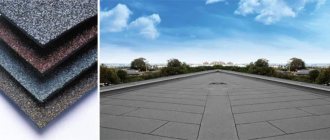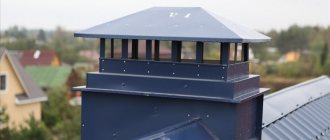Expanded clay - what is it?
We are absolutely sure that anyone over 10 years old knows the mysterious word “expanded clay.”
Many people believe that this is some kind of building material, or drainage felts, or plant bait, or something else... But few will answer the simple question: what is expanded clay? It will be difficult, and please describe the properties of this material. The range of applications is so wide that listing them would take a lot of time. It remains a big mystery where expanded clay is mined or maybe it is produced? And if they are made, then from what? Increasingly, when reviewing heat-insulating materials that have literally flooded our construction markets, the keywords for description are: new, modern, innovative, and so on. Indeed, the quantity, variety, and most importantly the high quality of numerous materials has recently become more and more surprising and pleasing.
Today we will talk about material that is well known from childhood. Let us, so to speak, eliminate the gaps in knowledge. Indeed, expanded clay is primarily a building material, which often finds its use outside the construction site. People who are very far from construction sites sometimes encounter expanded clay balls.
Expanded clay properties application
You don’t have to look far for an example; many have seen pots on windowsills with indoor plants, at the bottom of which small brown balls were placed. So these peas are the mysterious material that we are talking about. And at the bottom of the pot, expanded clay served only the role of excellent drainage for your favorite flowers.
Expanded clay is a lightweight material with a large degree of pores that is widely used in construction. Produced by firing clay. Clay shale is often used for the same purposes. The resulting expanded clay gravel takes on an oval, heterogeneous shape. There is also a concept: expanded clay crushed stone - the only difference between the material is its geometry, the “balls” are more like cubes with sharp edges and uneven corners.
It is not uncommon that the material can be found in the form of expanded clay sand, in which case the balls are very small, they are obtained by crushing, they are less porous and harder. Sand granules often become a constituent material in cement mortars used in construction. Expanded clay is distinguished into three fractions: 5-10 mm, 10-20 mm, 20-40 mm.
Expanded clay is produced from clay rocks containing about 30% quartz and ferrous impurities about 10%, as well as organic inclusions. That is why the material is essentially natural and natural, but it is prepared using an artificial method. Depending on how the clay or shale was fired, expanded clay is obtained with a range of volumetric mass - from 350 to 600 kg/m³ and higher when it comes to expanded clay sand.
How is expanded clay made?
The parent of expanded clay, as we have already noticed, is a special clay rock. The essence of the process is based on the well-known property of clay - to swell when heated. Special pyrogenic ovens, similar to drums, which rotate in a circle at a certain angle, are used in the preparation of expanded clay. Raw granules are fired to obtain a certain structure. Clay balls at an angle rush towards the burning torch.
Having received a heat shock of about 1200 degrees, the clay composition boils and swells. On the outside, the material melts and turns brown. Then comes one of the most important steps: cooling. The process consists of several stages. Surely builders know that there is such a term as “soil swelling coefficient”; it is this principle that is incorporated into the magical process of transforming clay mass into expanded clay. The firing itself lasts about 45 minutes.
Expanded clay technical characteristics
The classification of the material is determined by its bulk density, measured in kilograms per cubic meter, ranging from 250 kg to 1000 kg. This indicator is also called volumetric weight and is characterized as the ratio of volume to mass of the material. Expanded clay grades accordingly start with the value M 250 and end with the name M 1000.
Since the oven rotates, the granules take on an almost round shape with a diameter ranging from 0.2-0.4 cm. To make it easier to decide on the brand, it is enough to know the required size:
- fractions of 5-10 mm correspond to a grade of 450-400 kg/m3;
- fractions of 10-20 mm correspond to a grade of 400-350 kg/m3;
- fractions of 20-40 mm correspond to a grade of 350-250 kg/m3.
GOST regulates grades from 250 to M 600. Technical conditions everywhere allow the production of materials with values of M 800 and M 1000. In order not to get completely confused, you should remember a simple rule: lower grade - higher quality.
Expanded clay is one of the top ten organic thermal insulation materials that are constantly in demand in the construction market. The thermal conductivity coefficient strongly depends on the fractions and lies in the range of 0.06-0.17 W/m. The coefficient is characterized by a linear relationship: we reduce the size of the material - we increase the thermal insulation qualities.
Comparative table of thermal conductivity of materials
If the numbers do not provide a clear and understandable understanding of thermal conductivity, then we hope the figure below gives a clearer picture:
Let us add that expanded clay is also characterized by strength. The value varies from P15 to P400. If the number in the value is large, then this indicates better quality. Increased density gives the material correspondingly higher strength. Builders distinguish expanded clay into the following grades:
Expanded clay gravel
- The form is most in demand in the construction industry.
- The grains are spherical, sometimes oblong, irregularly oval in shape; after swelling of the clay they acquire a red-brown color.
- Grains are divided according to the size of the fractions into three groups: 5–10, 10–20 and 20–40 mm;
- It is often included in fillers of various brands of concrete, as it has high strength.
- The thermal conductivity coefficient is the lowest of all types of material. Gravel 10-20 mm grade by bulk density M350 coefficient value is not more than 0.14 W/m.
Expanded clay crushed stone
- Essentially it is crushed expanded clay mass. Large, oversized grains and granules are sent to the crusher, the resulting material is characterized by sharp, uneven edges
- The application does not go beyond filler into concrete mixtures. Crushed stone fraction – 5–40 mm.
Expanded clay sand
- In construction, it is most often used as insulation, with a fine fraction of up to 5 millimeters.
What expanded clay is needed for screed
Floor screeding can be done in two ways, both options have applications.
Dry screed
Before starting work, beacons are set up.
- A clean concrete surface is covered with plastic film extending onto the walls, 5 - 10 cm upward.
- Expanded clay is poured and leveled, the larger the size of the granules, the lower the load on the base.
- Dry material is easier to level over the surface than ready-mixed concrete.
- The even, compacted layer is filled with thin cement laitance.
Two to three days are needed for drying before the next work begins.
Wet screed
The prepared solution containing expanded clay is poured onto a prepared concrete base on which the film is laid. They also give time for drying, after which they produce the main thin screed for laying tiles, laminates, and other materials. Installation of beacons is mandatory; it is necessary to maintain the required level and not go beyond it.
The second option is more difficult in multi-storey buildings and apartments. It is necessary to deliver a concrete mixer or mixer to the floor, plus the ingredients for the solution. All this takes up space, which in this case is limited. This option is more acceptable in private homes, where there is room to spread out.
Screeding a floor with expanded clay concrete is cheaper than using regular concrete. Plus the floor turns out warmer and smoother.
The middle fraction is more suitable for screeding; it has a higher bulk density, which will avoid voids in the solution, but at the same time there will be a greater load on the base. If it is a floor on a floor, this factor must be taken into account.
Pros and cons of expanded clay
Expanded clay, a porous substance with low weight, is lighter than mineral wool and other foamed polymers, but it is durable. Its weight suggests insulation of the ceilings, since there is no significant load on the ceiling. At the same time, insulating floors followed by cement screed makes the process easier, since during work you can walk on the material without fear for its integrity. The main advantages of expanded clay lie in the following:
- high level of noise and heat insulation. The porous structure resists the propagation of sound waves, and as insulation, the granules work like a thermos;
- low volumetric weight;
- environmental friendliness;
- high resistance to mechanical stress, no rodents are afraid of it;
- expanded clay is completely safe for humans, no larvae grow in it;
- fire-resistant material that does not ignite;
- resistance to negative temperatures, frost resistance of at least 25 cycles;
- has durability, is not prone to rotting, does not form mold or fungi;
- neutral to chemicals;
- simple installation, can be done by one person without construction skills;
- low cost;
- does not decompose over time;
- widely used in growing domestic plants. Expanded clay prevents moisture evaporation, providing control of water balance;
- a popular substrate among gardeners.
With all its advantages, it is worth noting that expanded clay has some disadvantages:
- absorbs water easily, but dries poorly. Because the melted, brown crust is a ceramic coating that prevents drying. Perhaps this is not bad for hydroponics, but it is unacceptable for material - insulation;
- as insulation, it is recommended to fill in expanded clay, without further cement screed;
- good thermal insulation requires a lot of material; the backfill layer must be at least 500 mm.
Expanded clay
This group of ceramic products includes light brick, tripoli (diatomaceous earth), cellular piece products, and expanded clay.
Thermal insulating tripoli (diatom) products are made using the plastic method from tripoli or diatomite, sometimes with burnable additives. Based on average density, products are divided into grades 500, 600, 700. The thermal conductivity of such products at a temperature of 350° is 0.18...0.27 W/(m-°C). They are used for thermal insulation up to 900 °C.
Foam diatom products are made from tripoli or diatomaceous earth by preparing a dough from the powder of these materials and adding a stable foam to the dough. The resulting foam mass is poured into molds. After drying, the products are fired. The density of diatom foam products is 350..450 kg/m3, thermal conductivity at 25 °C is 0.08…0.12 W/(m-°C).
Expanded clay is a cellular material in the form of gravel. The raw materials for its production are clays containing iron oxides and organic impurities. During firing, gases (oxygen formed during the deoxidation of higher iron oxides, carbon monoxide formed during the combustion of organic impurities and dissociation of carbonates, water vapor formed during the dehydration of clay minerals) swell the clay at the moment of its transition to a pyroplastic state. Bulk density of expanded clay gravel (grade) 250... ...600 kg/m3, water absorption 8...25%, frost resistance of at least 15 cycles. The compressive strength (when compressed in a cylinder), depending on the grade of gravel, is not less than 0.6...2.5 MPa. Expanded clay is used as a filler for lightweight concrete and reinforced concrete (see Chapter 6), and also as thermal insulation backfill.
The name "expanded clay" is of Greek origin. If translated into Russian, this word means “burnt clay.”
Expanded clay is porous round granules that are obtained from clay by melting and firing it. This is an absolutely safe, environmentally friendly material with high heat and sound insulation characteristics, fire resistance and frost resistance.
Expanded clay is a natural material, its strength and durability are an order of magnitude higher than that of synthetic insulation.
Since expanded clay is made from clay, it is resistant to rotting, mold and mildew. The structure of expanded clay is not affected by hot or ice water or temperature changes.
Varieties of expanded clay.
Expanded clay sand is a lightweight aggregate for expanded clay concrete and mortars with particle sizes ranging from 0.14 to 5 mm. Also used for thermal insulation fills with a small thickness of the insulation layer (up to 50 mm).
Expanded clay gravel has grains with a fraction of 5-40 mm, is resistant to frost and fire, absorbs little water and does not include those impurities that are incompatible with cements. It is used as a filler in the production of lightweight concrete and is used as insulation in backfills on roofs, floors and walls.
Expanded clay crushed stone is a lightweight filler for expanded clay concrete of any type (the most common shape is angular) with a grain fraction of 5 to 40 mm, which is obtained by crushing large pieces of expanded expanded clay mass.
Expanded clay is also usually considered based on such indicators as: 1. Moisture absorption , expressed as a percentage of the weight of the dry filler. The resulting burnt outer layer helps to retain moisture penetrating inside, which is not available for fillers that lack such “protection.” We can talk about the defectiveness of the material if there is low porosity of the granules, which significantly increases the ability to absorb and retain moisture. High-quality expanded clay has a correlation coefficient of at least 0.46.
2. The ability to deform , predetermined by the porous structure of which expanded clay consists. Since the deformation coefficient of fillers such as expanded clay is not large, after the first test cycle most samples show the most accurate shrinkage result, which should not exceed 0.14 mm/m.
3. Thermal conductivity of the material is characterized by how well the expanded clay has passed through the glassy phase, which negatively affects this indicator. That is, the more glass, the lower the thermal conductivity of the material. High-quality expanded clay has a thermal conductivity of 0.07 - 0.16 W/m, which helps retain up to 80% of lost heat.
Production of expanded clay
The raw materials for the production of expanded clay are clayey rocks, mainly related to sedimentary rocks. Some rock-like clay rocks, shales, and mudstones are classified as metamorphic.
Clay rocks are distinguished by the complexity of their mineralogical composition and, in addition to clay minerals (kaolinite, montmorillonite, hydromica, etc.), contain quartz, feldspars, carbonates, ferruginous, and organic impurities.
Clay minerals make up clay matter - the most dispersed part of clay rocks (particles finer than 0.005 mm). Actually, clays are called clayey rocks containing more than 30% clay matter.
For the production of expanded clay, the most suitable are montmorillonite and hydromica clays containing no more than 30% quartz. The total content of SiO2 should be no more than 70%, Al2O3 - no less than 12% (preferably about 120%), Fe2O3 + FeO - up to 10%, organic impurities - 1-2%.
The suitability of a particular clay raw material for the production of expanded clay is determined by a special study of its properties. The most important requirement for raw materials is swelling during firing. Intumescence is characterized by the swelling coefficient.
The second requirement for raw materials (largely related to the first) is fusibility. The firing temperature should not be higher than 1250°C, and at the same time, the transition of a significant part of the smallest clay particles into the melt should ensure sufficient softening and viscosity of the mass. Otherwise, the gases formed during clay firing, which are not retained by the mass, will freely escape without swelling the material.
The third most important requirement is the required swelling interval. This is the name for the difference between the maximum possible firing temperature and the temperature at which the raw material begins to swell.
The temperature at which expansion begins is taken to be the temperature at which expanded clay with a granule density of 0.95 g/cm3 is already obtained. The maximum possible firing temperature is the temperature at which the surface of the granules begins to melt.
To expand the temperature range of swelling, a technique such as dusting raw clay granules with refractory clay powder is used, which makes it possible to increase the firing temperature and at the same time avoid melting of the granules.
How to choose high-quality expanded clay
Expanded clay is sold either packaged in bags or in bulk. In the first case, it is most likely a factory-sewn 30-liter bag, and in the second, you need to go to the base or “expanded clay plant” yourself and pack it as you want and in whatever you want. For minor apartment renovations, it is preferable to choose the first option.
First of all, you should pay attention to the appearance of the bags: if it is clean on the outside and light in weight, then you can count on the fact that inside there is even, not split, good expanded clay, grain by grain. If the bag is dirty, brown or red in color, then it is very likely that there is a lot of dust in the bag.
Scope of expanded clay
Due to its low cost and attractive properties, expanded clay is a very popular construction and heat-insulating filler. The material does not require specific skills to work with, it is lightweight, inexpensive, and accessible, which is why its scope of application is unusually wide and varied:
- production of facing and high-hollow ceramic bricks;
- production of expanded clay concrete blocks,
- insulation of floors, walls, attic floors, resulting in a reduction in heat loss by 70%;
- use as a porous aggregate in the production of lightweight concrete.
- everywhere in the construction complex: residential buildings, industrial buildings, country houses and much more, where this inexpensive material is in demand.
- as design solutions in the local area - various paving slabs, bulk structures;
- in agriculture, the water balance indicator stabilizes after the inclusion of expanded clay grains in the soil;
- in wastewater treatment plants, participates in rough cleaning using filters;
Houses built from expanded clay blocks back in the days of the Soviet Union still safely accommodate thousands of families throughout Russia and beyond for more than half a century. In addition to the fact that they have good strength and retain heat well, our climate is also conducive to the use of this frost-resistant and not capricious building material.
Many people remember these structures as “people's construction projects”. In general, it is worth noting that concrete or blocks made with the addition of expanded clay have high strength characteristics and remain light despite their large dimensions.
Production of expanded clay
In general terms, the process of making expanded clay is firing clay at high temperatures, more than 1000 degrees Celsius, for 40 minutes. As a result of sudden temperature exposure, the clay swells and acquires the necessary porous structure.
Stages of expanded clay production:
- clay preparation;
- burning;
- cooling of granules;
- sorting into fractions;
- packaging, warehousing, transportation.
Let us characterize four methods for making expanded clay.
- The plastic method is the most popular. Granules are formed from pre-moistened raw materials, which are fed into rotary kilns for firing. The plastic method is energy-consuming and complex, but it is popular because the result is high-quality expanded clay with high performance for each property.
- The dry method is the easiest. Here, the raw material is stone-like clay, which is crushed and then fired in a rotating kiln. Expanded clay at the output has a standard set of properties.
- Wet method. The clay is diluted with water before being placed in the rotary kiln. In the kiln the mixture is fired and granulated. This method of making expanded clay is used when the raw material is initially very wet.
- Powder-plastic is the most difficult method. First, a powder is made from clay, then it is diluted with water and granules are made, which are then fired in a kiln.
The use of expanded clay for floor insulation
The sequence of insulation of all types of floors has the same algorithm.
- free the surface from the old coating;
- Seal cracks and cracks with mortar;
- Flooring can be installed directly on an earthen base. First compact the earth, make a cushion of sand and pour gravel.
- Expanded clay must be insulated from moisture with a layer of waterproofing, using, for example, Izospan D.
- pour expanded clay onto the isospan film. Advice from experienced builders says that insulation requires a good layer. It is advisable to form a layer of at least 10 cm.
- Next we lay out the reinforced mesh
- We perform the screed with cement mortar.
- We lay out a vapor barrier - isospan C, then lay a new floor.
If you are insulating the ceiling, then it is better to use expanded clay of two fractions as part of the “pillow”. This technique will allow you to create a denser backfill, which more effectively retains heat in the living space.
In the recent past, it was problematic to buy expanded clay for private use, since it was sold in bulk and in large volumes. It was extremely inconvenient to buy an expanded clay machine, with little need. Nowadays, everything is much simpler and manufacturers pack their goods in bags of different volumes. You can buy expanded clay in packaging in the required quantity without overpaying for extra supplies. The packaging makes transportation easier and will not raise any serious questions.
We offer you an overview of the material in meeting gardening needs:
Calculation of expanded clay
The thickness of the insulating layer is calculated to ensure the correct choice of material. When performing mathematical calculations, the type of structure is taken into account.
Quantity of expanded clay for walls
Calculation of the amount of materials for floor insulation
It is necessary to calculate the thickness of the thermal protection taking into account:
- thermal conductivity coefficient – 0.17 W/mK;
- minimum backfill thickness – 20 cm;
- thermal resistance - according to the formula R = wall thickness/CTS (thermal conductivity).
According to SNiP 03/22/2003, the climatic conditions of the area are taken into account.
Calculating the amount of expanded clay for the floor
Calculations will help you find out the amount of material to fill under the screed and are performed as follows:
- With a standard layer thickness of 1 cm per square meter of room, 0.01 m3 of granules are needed. In liters the value is 10 l/m2.
- Calculating the amount of material using the formula V = S x R, where V is the amount of building material, S is the area of the floor covering, R is the cost per 1 square.
The larger the expanded clay layer, the more effective the thermal protection.
Calculation of roofing material
An example of calculating the amount of expanded clay for a roof
When calculating the insulation material, the formula V = S x h x K is taken into account, according to which:
- V – volume of clay fractions;
- S – insulated area;
- H – thickness of thermal insulation;
- K – shrinkage coefficient. For a flat roof it is 1.2, for a pitched roof – 1.1.
Manufacturers supply bulk material in bags, where the volume is indicated in liters. 1 cubic meter is equal to 1000 liters, so the final result must be multiplied by 1000 and divided by liters in the bag.
Expanded clay is very popular as a high-quality insulation material for foundations, walls, floors and roofs. The reason for using the material is ease of installation, excellent thermal insulation properties and low cost. Before starting work, it is necessary to calculate the volume of granules and select a technology.
What is the most profitable way to insulate a wooden house with expanded clay?
The issue of insulating wooden houses, including those with a pile or strip foundation and built using frame-panel technology, today mainly comes down to installing an additional layer of insulation from mineral insulation materials. However, the insulation of a wooden house with expanded clay today is gradually beginning to take center stage due to more accessible technology and the cost of work. The popularity of insulating walls with expanded clay is due to the relatively low cost of work and the excellent technical qualities of expanded clay concrete blocks as the main insulation material.
External or internal insulation?
When considering the insulation of a wooden house with expanded clay, the option most often considered is to install an outer layer of expanded clay concrete blocks followed by plastering the walls. This insulation option is rational when it is possible to install a reliable foundation under a layer of insulation, because, despite the relatively light weight of expanded clay concrete block, a wall made of such blocks has quite an impressive weight.
The construction of the internal layer of insulation of a wooden house with expanded clay is mainly used with half-hollow expanded clay concrete blocks or by filling the cavities between the outer and inner walls with dry expanded clay.
For erected buildings, insulation of walls with expanded clay is carried out from the outside, and, if conditions permit, dry expanded clay is poured into the cavity between the wall and the block or into the voids of the blocks themselves.
A feature of wooden buildings has always been the need to carry out operations to preserve wood, protect it from biological pests and impregnate it with special fire-fighting mixtures. When installing external insulation of a wooden house with expanded clay, the wooden parts must be impregnated before erecting a wall of expanded clay concrete blocks.
For interior work, it is planned to insulate the floor by constructing a cushion of dry expanded clay followed by installing a concrete screed using expanded clay as a filler. The use of expanded clay insulation for the ceiling space is determined by the condition of the ceiling and attic floor.
The use of expanded clay as insulation for wooden buildings will reduce the cost of heating a building by 20-25% just by insulating the walls.
Do-it-yourself insulation - procedure
Before you start installing thermal insulation, prepare everything you need for work. Clean the pipe from dust, repair cracks and chips. It is important that the surface is dry, otherwise the quality of thermal insulation will decrease.
Plastering
- The mixture is mixed with water using a construction mixer in the proportions specified by the manufacturer. It is better to first pour water into the container and then add the dry mixture.
- Using a spatula or trowel, the solution is applied in spots over the entire surface of the pipe and leveled.
The plaster solution is leveled over the entire surface of the pipe
In order for the layer of plaster to adhere to the surface of the chimney, a reinforcing mesh is used
Video: plastering and insulating the chimney
Lining or sandwich chimney
- To do this, you will need a steel or galvanized pipe with a diameter 6-10 cm larger than the chimney and mineral or basalt wool.
- The chimney is wrapped with a layer of insulating material. The layer thickness must be at least 5 cm, the winding is overlapped.
- The layer of cotton wool is fixed with turns of wire or foil tape.
Shelling is done using insulation and pipes of larger diameter
When working with fibrous materials, protect your respiratory system with a mask or a damp cloth with an elastic band.
Video: instructions for making a sandwich chimney
Lining a brick chimney
The method described above is suitable for metal and asbestos chimneys; brick chimneys will require a lot of effort and time.
- The insulation mats are cut to the size of the chimney walls and attached to them using binding wire or tape. In some cases, sheathing may be necessary.
Effective sound insulation with expanded clay
A comfortable stay in a room where the sounds of the outside world do not seep through is in many ways today a condition imposed on a living space. However, it often happens that a completely comfortable room suitable for habitation is constantly exposed to sound from the outside or (which is even more common in multi-story buildings) the partitions are so thin that they allow all sounds from the adjacent room to be clearly perceived. There is a way out of this, and it is quite affordable both in price and technology - soundproofing with expanded clay.
Possessing excellent thermal insulation properties, expanded clay also acts as an excellent soundproofing agent: the structure, heterogeneous in shape and weight, perfectly dampens sounds and creates comfort and coziness.
Expanded clay for flooring - what is good?
Expanded clay is widely used as insulation due to its exceptional properties:
- Expanded clay has excellent heat and sound insulation.
- moisture and frost resistance, fire resistance.
- high strength with low weight.
- long service life.
- resistance to chemical influences.
When using expanded clay for floor insulation, you must remember that this surface, unlike walls and ceilings, is constantly subject to heavy loads. Accordingly, it is necessary to calculate the thickness of the expanded clay layer and the cement layer for the screed, taking this circumstance into account. Expanded clay for the floor is poured onto a waterproofing layer. The insulation is overlapped on the walls to a height not less than the thickness of the layer of expanded clay gravel being poured.
Before pouring expanded clay for the floor, it is necessary to determine in advance the level of the future surface and place marks along its contour. When using expanded clay for insulation and sound insulation, it is necessary that the layer of material be at least ten centimeters thick. It must be remembered that the cement mortar used to pour expanded clay gravel must completely harden and become durable. This requires about 21-28 days.
